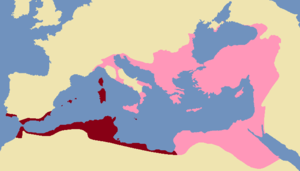
Byzantine rule in North Africa spanned around 175 years. It began in the years 533/534 with the reconquest of territory formerly belonging to the Western Roman Empire by the Eastern Roman (Byzantine) Empire under Justinian I and ended during the reign of Justinian II with the conquest of Carthage (698) and the last Byzantine outposts, especially Septem (708/711), in the course of Islamic expansion.[1]
The region's administrative structure was initially in line with the typical late Roman administrative structures that had been existing for the past 300 years. Civil powers were thus in the hands of a Praetorian prefect, the head of the supreme civil administrative authority in the Late Roman Empire. The military powers, however, were incumbent on a Magister militum per Africam. These powers were merged into single office from 591 at the latest, and East Roman North Africa became the heartland of one of two exarchates, with the founding of which the East Roman Emperor Maurice (582–602) was able to counteract the consequences of imperial overstretch through bundling and decentralization. No further change in these administrative structures took place until the end of Byzantine rule.
The reconquest of this region was of the greatest strategic and economic significance and the most enduring of all conquests in the West. While the Lombard kingdom was established in parts of East Roman Italy after 568 and East Roman rule in southern Spain came to an end amidst the final and most desperate Roman-Persian war, the areas reconquered in the Maghreb remained entirely in the East Roman hands until the Islamic expansion. This made the region the most important cornerstone of Eastern Roman/Byzantine power in the West.
| History of Tunisia |
|---|
 |
|
|
| History of Algeria |
|---|
 |
- ^ The time of Arab conquest of the last Byzantine outpost is uncertain, compare only Walter Kaegi: The Islamic conquest and the defense of Byzantine Africa. In: Susan T. Stevens, Jonathan P. Conant (editor.): North Africa under Byzantium and Early Islam. Dumbarton Oaks Research Library & Collection, Washington (D. C.) 2016, ISBN 978-0-88402-408-8, p. 65–86, escpecially S. 70–71, who assumes 711; but also Susan Raven: Rome in Africa. 3. Auflage. Routledge, London u. a. 1993, ISBN 0-415-08150-5, S. 229, who puts the conquest '10 years after the fall of Carthage and emphasises that only Arab and Visigothic sources are available for this subject. This concurs with Walter E. Kaegi: Muslim Expansion and Byzantine Collapse in North Africa. Cambridge University Press, Cambridge 2010, ISBN 978-1-107-63680-4, page 155, who states that Ceuta is referred to in Byzantine sources for the last time in 641.
